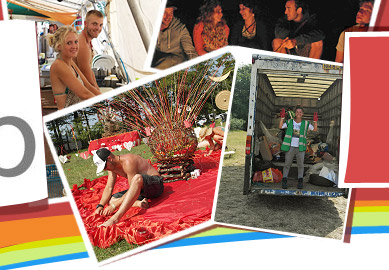Volunteer Abroad > Workcamps (2 to 4 weeks)

Workcamps typically bring together a temporary community of 8-30 international volunteers from different backgrounds to provide services to local community projects. The volunteers carry out unskilled tasks that would not otherwise be possible. The practical work is only part of the main objective. The work is a tool and method to promote intercultural understanding and friendship between the volunteers and with the local community.

Taking part in an international workcamp is an extraordinary experience. For a short time you become part of a new social unit made up of people from different countries and cultures; living and working together to achieve a practical task in sometimes basic circumstances. Through this shared experience, strong friendships develop and every day brings new experiences, both social and personal.
A voluntary workcamp is a wonderful learning experience on many levels, particularly for languages, but also for practical work skills, social and interpersonal skills, geographical and intercultural experience, self awareness, understanding the realities and hopes of the hosting community, seeing life as it is from a wholly different perspective… Tolerance of differences, a willingness to share, a sense of humour and a constructive approach to solving interpersonal problems are essential qualities for workcamp volunteers.
Participation in a voluntary workcamp makes it possible to experience different areas and aspects of countries and cultures not usually accessible to foreigners. It is a unique opportunity for people of different nationalities, ages, abilities, social, cultural and religious backgrounds to live, work, and co-operate together. A temporary democratic international community is established for the period of the project and this is itself a fascinating experience.

Workcamps typically bring together a temporary community of 10-30 international volunteers from different backgrounds to provide services to local community projects. The volunteers carry out unskilled tasks that would not otherwise be possible. The work tasks vary widely from construction projects, agricultural development, nature conservation, renovation of historical monuments, festival preparation, archaeological work or social projects involving children, families, the elderly, refugees and people with special needs... The practical work is only part of the main objective. The work is a tool and method to promote intercultural understanding and friendship between the volunteers and with the local community.
Participants on voluntary workcamps, are not tourists, nor are they development workers. They can expect to give around 30-35 hours unskilled work a week, and become closely involved with the local community who will provide the expertise. Naturally, volunteers only need to work as hard as they are able. However, they must remember that many people have contributed a great deal of time and effort to make the project possible. Each workcamp is managed by the local community organisation but the volunteers are in charge of their own domestic arrangements.
There are usually some cultural activities outside the work programme such as visits to local sites of interest, to other projects, homestays with local families, discussions on particular topics, etc. The volunteers themselves sometimes choose the activities.
On most projects, some of the volunteers are nationals of the host country. On almost all projects there will be one or more responsible people acting as co-ordinators and technical leaders for the work. They live and work with the volunteers and normally are volunteers themselves. These co-ordinators are chosen and trained by the hosting organisations. They depend on the full participation of each volunteer, so it is the responsibility of the whole group to ensure the project’s success.

The voluntary workcamp method was invented in 1920 after the First World War. It was created to bring together volunteers from the former enemy countries to carry out reconstruction work and as a means of allowing them to consider their recent past. For this reason the ‘workcamp movement’ has always been closely allied to and part of the broader ‘peace movement’.
In the early years the focus was mainly on reconstruction and disaster relief, with with some social and environmental initiatives. Volunteers usually stayed for months rather than weeks. By the time there was new need for reconstruction after 1945, the modern workcamp formula was generally accepted and the workcamp movement grew so much that it achieved UN recognition with the creation of the Co-ordinating Committee for International Voluntary Service (CCIVS) in 1948.
The international voluntary service movement has grown to a global scale and has over the years adapted to new aims for sustainable development, national independence, human rights and ecological protection. It is now active in over 90 countries and has been copied by many other types of organisation.

The Standard Programme involves those exchanges that evolved out of the post war reconstruction projects in post 1945 Europe. These exchanges between the European, North American, Japanese and South Korean organisations are the most highly developed and popular.

Among our most exciting, challenging and fulfilling projects are those which take place in developing countries. In our work we use the expressions “North” and “South”. The “North” represents the generally rich societies of Eurasia, North America and Australasia. The “South” refers to Africa, Latin America and Asia (with the exception of Japan, Taiwan and South Korea); the so-called “developing countries” which have suffered political, economic and cultural domination by the countries of the North in the last two centuries.






 yap-uk
yap-uk +44 0208 123 5927
+44 0208 123 5927














